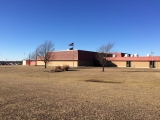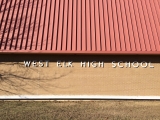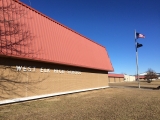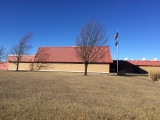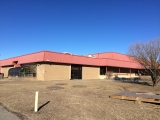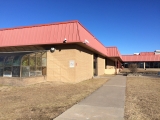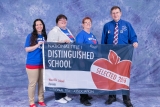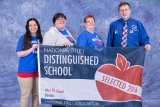-
Category 2
Selected in 2016
-
Grades: pre k - 12
School Setting: rural
Town Population: 550
Student Enrollment: 365
Student Demographics:
Black/African American: 1%
Teacher/Student Ratio: 1:10
White/Caucasian: 93%
Hispanic: 3%
Hawaiian/Pacific Islander: 0%
Asian: 1%
Native American: 2%
Other: 0%
% Reduced Lunch: 57%
% ELL Learners: 0%
Founded: 1965 -
PRINCIPAL:
Martin Burke -
CONTACT:
P.O. Box 607
Howard, KS 67349
620-374-2113
bmoore@sktc.net
West Elk School
Howard, KS
All students are included in high expectations to meet grade level content outcomes. We also provide supplemental programs for students needing more time to learn.
- Describe specific programs in place to ensure that families are involved in the success of your school and students.
- Our building has an active parents group that meets regularly as well as a building "site council". We offer conferences twice per year and openly invite parents to contact teachers or administration if they have any questions or concerns. We also provide permission slips for our Title I services annually, a parent night for Title I parents, and a compact with Title I parents. Our school website is also used to share activities, events, and major happenings with our parents as well the elementary newsletter is sent home weekly with students and posted on the website.
- Describe the most successful activity your school has initiated to strengthen ties to your community.
- Our district is located in a "frontier" county here in Kansas and the school is the center of the community. The activities provided by the school include sports events, music programs, and the school play draws many persons from the townships that make up our school district attendance area. Our district also offers a "community service" day and completes projects in our regional communities.
- Describe your philosophy of school change or improvement.
- School improvement is an on-going process of having high expectations for student achievement that includes ALL students. When all faculty and support staff are tied to student achievement through the district's evaluation process, then it becomes the defining characteristic of a positive school culture that focuses on doing whatever it takes to ensure that all students meet grade level outcomes in all content areas.
- What are your school’s top two goals for the next year?
- Our top goal is to continue to replicate the programs and services we have in place that have made a difference for ALL of our students based on our state assessment data. A second goal is to continue to look for gaps in our curriculum or instruction and ensure that all teachers have the resources they need in their classrooms to teach ALL students (both personnel, technology, and materials).
- What is the single most important factor in the success of your school that others could replicate?
- Focus your efforts on quality instruction aligned to your district's adopted content curriculum. This is accomplished by taking a close look at the data collected by the school for each student, for each classroom, for each grade, and for the school as a whole. Ensure that ALL students are included in high expectations for each student to meet grade level content outcomes and provide supplemental programs (after school or summer) for those needing more time to learn the content.
- Describe the program or initiative that has had the greatest positive effect on student achievement, including closing achievement or opportunity gaps, if applicable.
- Our teachers are currently involved in a project designed to "Build Your Own Curriculum". This includes ALL teachers from PreK through all high school content classes. We also use our assessment data (both formative and summative). We have been able to add specific gaps we have identified to ensure that each teacher meets the grade level standards for all content areas. It is through this "drill down" process of selecting what are the important indicators to address that we have closed the gap. This is accomplished through our support staff which includes Title I "targeted assistance" direct instruction, an after school tutoring program, summer services, and a 21st Century grant that is offered during the summer months to our elementary students (K-8). We also have a progressive special education support network with support staff available to assist struggling students with an IDEA IEP. Our Title I teacher is one of our after school tutors.
- Explain how Title I funds are used to support your improvement efforts.
- Title I funds are used through our targeted assistance Title I services in the areas of Reading (ELA) and Mathematics in grades K-6. The Title I services include a licensed teacher who has worked for the district for over 25 years, and 2 Title I Aides. All of our funds support the salary and benefits for the teacher and one of the paras. We use At-Risk state dollars and local funds to support the second Title I Aide's position/benefits.
- Identify the critical professional development activities you use to improve teaching and student learning.
- Our four inservice days are designed to focus on student achievement and defining where gaps exist. We then ask our teachers and support staff to select professional development activities that will assist them with their individual needs. For the building-wide inservice days, we dedicate time for all teachers in PreK through grade 12 to receive quality professional development designed around our accreditation plan which includes curriculum discussions, Build Your Own Curriculum, school safety, required state trainings, and a large amount of time for elementary staff to meet together to address their specific needs. We allow teachers to attend regional and state conferences aligned to their professional development plans, and administrators often target areas of need they identify during the classroom evaluations of individual teachers that include professional development opportunities to address any areas for professional development identified by the administration or teacher.
- Describe how data is used to improve student achievement and inform decision making.
- Our teachers use data based decisions when drilling down to discover what areas of the curriculum our students are not performing as well as we think they should be. This is specific to the English Language Arts and Mathematics data. We also utilize weekly data from the Study Island program, curriculum based data from classroom performance for each student, state assessment data in English Language Arts, Mathematics, Science and Social Studies, as well as the Dibels data we collect for all K-6 students that is used by our Title I program as a progress monitoring tool. Our school counselor and principal share the data with teachers who then work cooperatively to align their instruction to ensure that any weaknesses are addressed. We also select interventions and supplemental programs whenever we think we need a different approach to reach a student or group of students.
- Describe your school culture and explain changes you’ve taken to improve it.
- We consolidated our elementary schools to the grade 7-12 building in 2010 by adding 4 modular units and consolidating space in the existing building. We have been working on "healing" of our two communities that lost their elementary schools when our enrollment dropped over a 10 year period from 540 students to almost 300 students. We have a website and post all of our school events and notices to the public on the website. We also have developed a weekly elementary newsletter with challenges and activities for our families to complete with their children.
Stats
-
Category 2
Selected in 2016
-
Grades: pre k - 12
School Setting: rural
Town Population: 550
Student Enrollment: 365
Student Demographics:
Black/African American: 1%
Teacher/Student Ratio: 1:10
White/Caucasian: 93%
Hispanic: 3%
Hawaiian/Pacific Islander: 0%
Asian: 1%
Native American: 2%
Other: 0%
% Reduced Lunch: 57%
% ELL Learners: 0%
Founded: 1965 -
PRINCIPAL:
Martin Burke -
CONTACT:
P.O. Box 607
Howard, KS 67349
620-374-2113
bmoore@sktc.net


